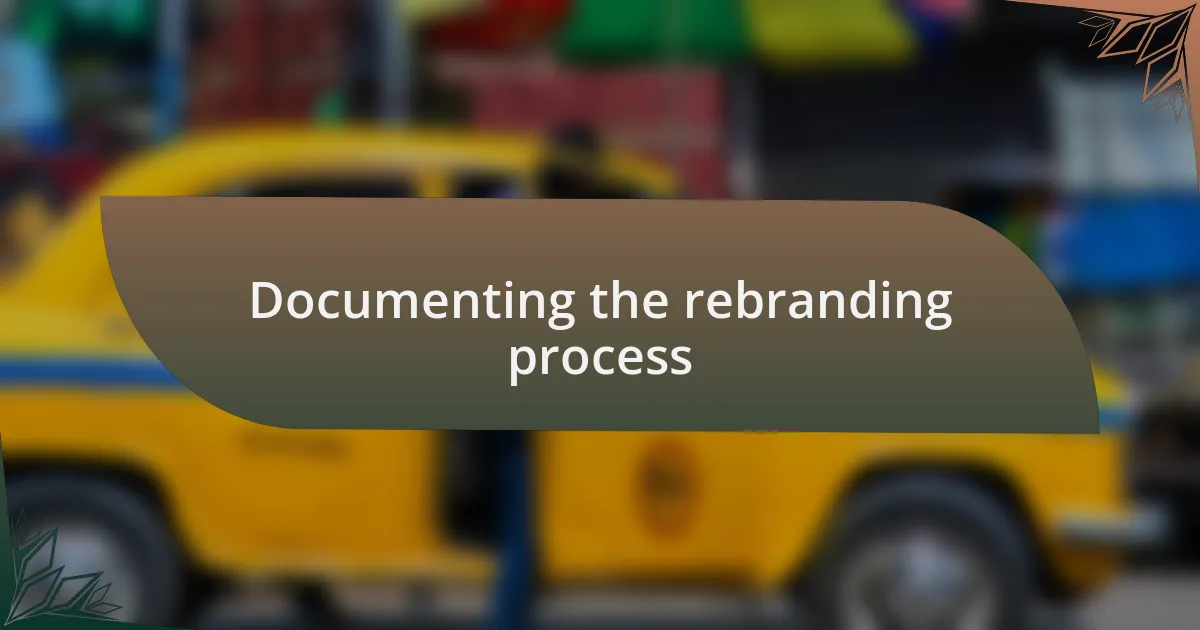Key takeaways:
- Rebranding is an evolution of a brand’s identity, reflecting growth and aligning with audience expectations.
- Key reasons for rebranding include a shift in personal style, attracting new audiences, and serving as a marketing tool.
- Identifying the target audience and creating detailed client personas significantly enhances portfolio relevance and appeal.
- Authenticity and vulnerability are crucial in rebranding, fostering deeper connections and building trust with the audience.

Understanding web design rebranding
Rebranding in web design goes beyond just changing the aesthetics; it’s about evolving the identity and purpose of the brand itself. I remember when I updated my own portfolio, wrestling with my fear of letting go of parts of my old identity. It was a reminder that sometimes, it’s necessary to shed the old in order to embrace new opportunities.
When considering rebranding, think about your audience’s perception. I once conducted a survey among my clients to gauge their thoughts on my previous design style. The feedback revealed that while they enjoyed the existing look, they were eager for fresh ideas and approaches. This made me realize that rebranding isn’t just a personal journey; it’s also about aligning with the aspirations of those we serve.
I’ve found that the process of rebranding can feel daunting, but it can also be invigorating. It forces you to reflect on what truly represents your values and vision. Have you ever thought about how rebranding might unlock new creative possibilities for you? Each project has a unique story; sometimes, all it takes is a fresh perspective to tell it.

Reasons for rebranding a portfolio
Rebranding a portfolio often comes from recognizing a shift in personal style or skills. I recall a moment when I was browsing through my old projects and felt a disconnect with the work I was showcasing. It dawned on me that my portfolio should reflect my growth and the evolution of my design aesthetic—not just the skills I once had, but the innovative approaches I was excited about today.
Another compelling reason to rebrand is to attract a different audience. I once decided to pivot my focus from corporate clients to small businesses, and a portfolio overhaul was essential. By presenting work that resonated with the new target market, I was able to create an appealing narrative that showcased how my design capabilities could directly benefit them.
Finally, rebranding can serve as a powerful marketing tool. When I revealed my newly redesigned portfolio, I noticed a significant spike in engagement. It was like revealing a fresh coat of paint on a familiar building; it sparked conversations and renewed interest in my work. Have you ever considered how a reimagined presentation of your projects might breathe new life into your professional journey?

Assessing your current portfolio
To effectively assess your current portfolio, start by examining the projects that truly resonate with you. I remember going through my own portfolio and encountering pieces that, while technically sound, no longer sparked joy. It’s crucial to ask yourself: do these projects reflect who I am today? If the answer is no, it’s a clear sign that a rebranding is in order.
Next, think about the feedback you’ve received over time. I vividly recall a client who raved about one of my more experimental designs but overlooked the safer, conventional projects. This feedback opened my eyes to the kind of work that not only excites me but also captivates others. Are you noticing patterns in the responses you receive? Your audience’s reactions can be telling and should guide your portfolio direction.
Lastly, it’s essential to consider the visual and thematic aspects of your portfolio. When I revisited mine, I realized that my color choices and layout didn’t align with my current style. This misalignment can confuse viewers and dilute your brand’s message. Reflect on whether your visual identity accurately captures your essence as a designer and if it’s truly representing what you wish to convey to potential clients. How does your current presentation measure up against the narrative you want to tell?

Identifying your target audience
Identifying your target audience is crucial for a successful rebranding strategy. I once discovered that my ideal clients were not the ones I initially thought. I had been focusing on a broad market, thinking it would yield better results, but when I started to narrow down my audience, I felt a shift in energy. I realized I was most passionate about working with small businesses that value creativity, and that clarity allowed me to tailor my portfolio to appeal specifically to those clients.
It can be helpful to create a persona representing your ideal client—a detailed profile that includes their goals, challenges, and preferences. I remember crafting a profile based on a delightful collaboration I had with a local café owner. This exercise clarified how to connect with similar businesses, as it sharpened my focus on their specific needs. Have you ever thought about who you enjoy working with the most? Shaping your portfolio around that vision not only enhances your appeal but makes your work more fulfilling.
Understanding the demographic aspects of your audience—such as age, interests, and location—can influence your design choices significantly. For instance, when I began targeting millennial entrepreneurs, I noticed my color schemes shifted toward brighter, more vibrant palettes that spoke to their energetic nature. Are your designs resonating with your intended audience? Recognizing the nuances between different groups can help you align your visuals with their preferences, making your portfolio a magnet for the clients you truly want to attract.

Designing a cohesive brand identity
Designing a cohesive brand identity is about creating a unified visual and emotional experience that resonates with your target audience. I learned this firsthand when I revamped my logo and color palette to reflect a more modern aesthetic that appealed to my audience. It was a little daunting at first—would the changes alienate existing clients? Instead, I found that the new identity attracted even more clients who felt an immediate connection to the fresh, cohesive look.
Consistency in design elements is key; this means choosing specific colors, typography, and imagery that work harmoniously together. I recall a time when I opted for varying styles across my portfolio, thinking it showcased my versatility. Instead, it confused potential clients about my brand’s essence. Once I standardized my design choices, I noticed a significant boost in engagement—people were drawn to a clear message and identity that I had previously overlooked.
Have you ever considered how a cohesive identity builds trust with your clients? I found that consistency in branding not only communicated professionalism but also made my work more recognizable over time. By making intentional choices aligned with my brand’s voice, I created a visual identity that told a story—my story—and that has genuine emotional resonance with my audience. This journey towards cohesion has made my portfolio not just a showcase of work, but a reflection of who I am as a designer.

Documenting the rebranding process
Documenting the rebranding process was more than just a technical task for me; it was an emotional journey of discovery. I began by reflecting on my original brand and asking myself what truly represented my work. I wanted to capture my evolution as a designer, so I maintained a journal where I recorded my thoughts, sketches, and inspirations at every stage. This documentation turned out to be invaluable—it’s like looking back at a photo album of my creative growth.
As I navigated the rebranding, I faced the challenge of gathering feedback. I invited a few trusted colleagues to review my initial designs, and their insights sparked unexpected ideas I hadn’t considered. For instance, a simple suggestion to adjust my typography not only enhanced readability but also brought warmth to the overall look. This experience taught me that collaboration can illuminate blind spots, making the rebranding process feel less isolating and more like a shared journey.
Tracking milestones during the rebranding was essential for me to see progress. I created a timeline that highlighted crucial decisions—from selecting the right brand voice to finalizing the website layout. Often, I would pause to celebrate small victories, like completing the new logo or getting positive feedback on a color scheme. These moments reinforced my commitment to the new identity, helping me realize that each step brought me closer to a brand that genuinely reflected my vision and aspirations. Isn’t it fascinating how such a thoughtful approach can transform not only your brand but also your connection to it?

Lessons learned from personal experience
One of the biggest lessons I learned during my rebranding journey was the importance of staying authentic. I still remember the moment I almost compromised my vision, swayed by trends instead of my core values. It hit me that my brand should resonate with who I am and what I stand for. Have you ever found yourself tempted to follow what everyone else is doing? I realized that authenticity not only strengthens your brand but also builds trust with your audience.
I also learned that embracing vulnerability can lead to powerful connections. When I decided to share my struggles and uncertainties about the rebranding process on my social media, the response was overwhelming. People appreciated the honesty, and many shared their own challenges. This taught me that by being open, I could foster a community that genuinely engages with my work. Have you considered how your own vulnerabilities could create deeper relationships with your audience?
Finally, setting clear goals for the rebranding was crucial for maintaining focus. I recall a time when I allowed creative distractions to steer me off course. I had multiple ideas swirling in my mind, making it challenging to choose a clear direction. Implementing a goal-setting framework helped pull me back and prioritize what truly mattered. Have you ever felt lost in your creative process? It’s evident that clarity not only boosts productivity but also aligns your creative efforts with your brand’s purpose.